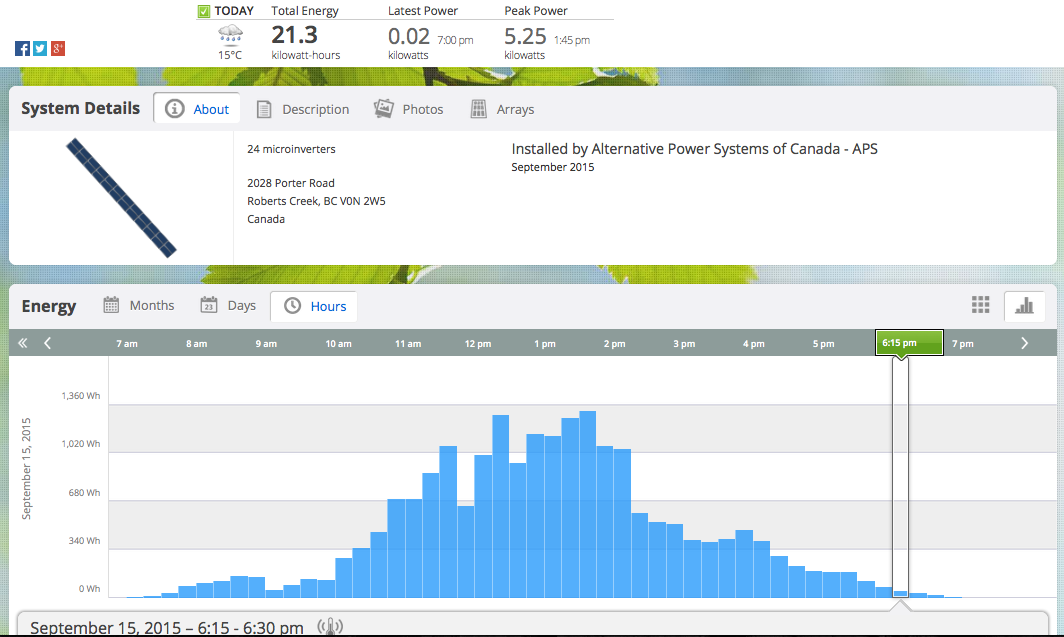Is a solar installation really a good idea? I think the appropriate answer to this question really is …. it depends.
If you are looking at solar as an alternative energy strategy there are several key things to consider. In British Colombia, we make our power from hydroelectric, which at present is a renewable resource that has very low environmental impact once the source of the power generation (dams and turbines) are established. Hydroelectric power production is also very efficient in production however is fairly inefficient in distribution, like most conventional power production. This makes our power the “cleanest” in production but not so great for getting this clean product to its users.
Alternatively, if our power generation came from nuclear, which is also very efficient and fairly “clean” but extremely dangerous situated on the “ring of fire” or coal burning, which is down right nasty, I would say the decision would be easier. Solar is the way to go!
Perhaps we tackle the question based on convenience. Recently, many people experienced power outages that lasted up to 5 days in the lower mainland. Pretty annoying, but if you had solar or even battery backup, you would have been fine! Although these outages are frustrating, is that really a reason to go solar? Once again … I think the answer is …. it depends.
Our decision to install a net zero solar system really came from a desire to be less reliant on conventional power production, as well as, provide us with many options for using and storing our generated power in the future.
But before we go there, consider the environmental costs to that decision. We purchased 1000 lbs of electrical equipment that has an environmental cost associated with it, plus if we add battery storage to our system, which will be done in 2016, that also comes with an environmental price.
So what are the benefits. Well for one the system is guaranteed for 35 years! A large part of our decision to invest in alternative energy production is gambling on the fact that a lot might happen to us humans in that time. Certainly our power costs will likely go up, but our power needs may also go down. Or will they? Another tough question to answer. But according to climate change predictions … we might see some pretty crazy weather in the next 35 years, which would likely result in more energy needs. Another thought to consider in this section is a natural disaster. Although, we certainly are not counting on this, predictions for some form of natural disaster on the westcoast are pretty grim.
Once again, clearly the largest benefit will come in the form of self sufficiency. We can heat water and ourselves, run pumps, and grow food year round all with our own power, not to mention being able to cook and do laundry. And all of this will be possible with the Powerwall.
The powerwall is the invention of Tesla Motors and a solution to the biggest issue that affects self sufficiency. How do you store your power? Old methods of storage are why solar failed in the past. The lead acid battery is terrible. Nickel Cadmium batteries are not much better, but with new battery technology, which is small and less environmentally impactful we can store power that we produce and comfortably go completely “off the grid” with very little effort. http://www.teslamotors.com/powerwall
The final and most important thought that needs to be considered is efficiency of solar generation in our northern latitude. This was a question that I really did not know the answer to until our system was installed. After going back and forth with what to get we ended up with 6 kilowatt micro-inverted “grid-tied” solar system. This generates anywhere from 3 kilowatt hours to 40+ kilowatt hours per day. Confused yet? I certainly was, until I looked at my BC Hydro bill and used an online off-grid solar system calculator (http://www.wholesalesolar.com/solar-information/start-here/offgrid-calculator) both of which suggested a current usage of about 10 kilowatt hours per day.
Now for the cool part. Solar can generate quite a lot of power without sun! Boom! Solar systems can generate power even with deflected sun from the moon (AKA at night!). But the most important advantage we have in northern latitudes is that our panels can be kept a lot cooler which makes their efficiency much greater. A hot panel is an unhappy panel … so even though southern California has a lot more sun, solar power generation is a lot less efficient because of heat building up in the panels.
A good example of this, was on September 15th, which was a very cloudy, moderately rainy day. We where able to generate 20+ kilowatts of power. This is actually 3 times the amount that we used on that day. With our “grid tie” we sold this power to BC Hydro for 10 cents per kilowatt and made $2.13! Although this doesn’t sound like a lot, considering the cost of our installation ($18000) over a period of 10 to 15 years, our system will truly be “net-zero”.

